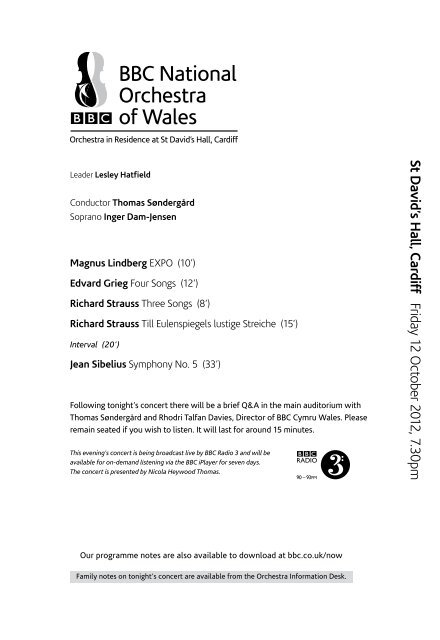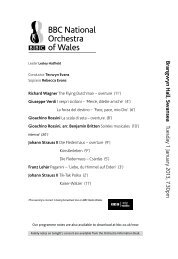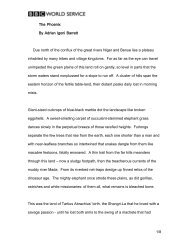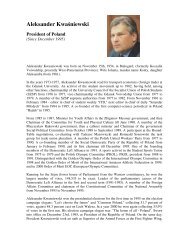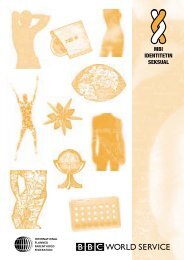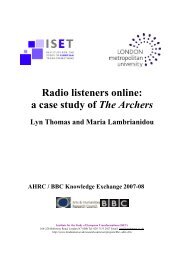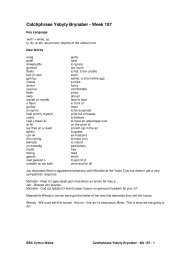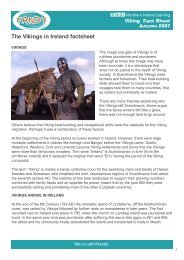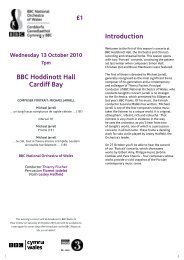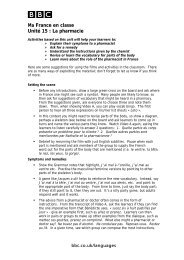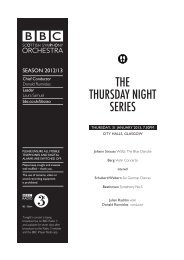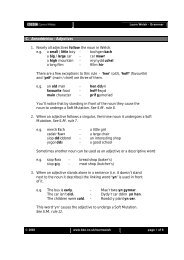Find out more by downloading our programme notes - BBC
Find out more by downloading our programme notes - BBC
Find out more by downloading our programme notes - BBC
Create successful ePaper yourself
Turn your PDF publications into a flip-book with our unique Google optimized e-Paper software.
Leader Lesley Hatfield<br />
Conductor Thomas Søndergård<br />
Soprano Inger Dam-Jensen<br />
Magnus Lindberg EXPO (10’)<br />
Edvard Grieg F<strong>our</strong> Songs (12’)<br />
Richard Strauss Three Songs (8’)<br />
Richard Strauss Till Eulenspiegels lustige Streiche (15’)<br />
Interval (20’)<br />
Jean Sibelius Symphony No. 5 (33’)<br />
Following tonight’s concert there will be a brief Q&A in the main auditorium with<br />
Thomas Søndergård and Rhodri Talfan Davies, Director of <strong>BBC</strong> Cymru Wales. Please<br />
remain seated if you wish to listen. It will last for around 15 minutes.<br />
This evening’s concert is being broadcast live <strong>by</strong> <strong>BBC</strong> Radio 3 and will be<br />
available for on-demand listening via the <strong>BBC</strong> iPlayer for seven days.<br />
The concert is presented <strong>by</strong> Nicola Heywood Thomas.<br />
Our <strong>programme</strong> <strong>notes</strong> are also available to download at bbc.co.uk/now<br />
Family <strong>notes</strong> on tonight’s concert are available from the Orchestra Information Desk.<br />
St David’s Hall, Cardiff Friday 12 October 2012, 7.30pm
<strong>BBC</strong> National Orchestra of Wales<br />
Forthcoming concerts<br />
St David’s Hall, Cardiff<br />
Friday 2 November 2012, 7.30pm<br />
WAGNER Lohengrin – Act 1 Prelude<br />
BRAHMS Violin Concerto<br />
ZEMLINSKY Lyric Symphony<br />
Conductor Jac van Steen<br />
Violin Viviane Hagner<br />
Soprano Elizabeth Atherton<br />
Baritone Roman Trekel<br />
Friday 14 December 2012, 7.30pm<br />
HANDEL Messiah<br />
Conductor François-Xavier Roth<br />
Soprano Susan Gritton<br />
Mezzo-soprano Delphine Galou<br />
Tenor Topi Lehtipuu<br />
Bass Matthew Brook<br />
<strong>BBC</strong> National Chorus of Wales<br />
Friday 25 January 2013, 7.30pm<br />
BEETHOVEN Piano Concerto No. 5, ‘Emperor’<br />
BRITTEN Spring Symphony<br />
Conductor David Atherton<br />
Piano Paul Lewis<br />
Soprano Elizabeth Atherton<br />
Alto Jennifer Johnston<br />
Tenor Andrew Kennedy<br />
<strong>BBC</strong> National Chorus of Wales<br />
Cardiff Polyphonic Choir<br />
<strong>BBC</strong> Hoddinott Hall, Cardiff Bay<br />
Tuesday 16 October 2012, 2.00pm<br />
PROKOFIEV Symphony-Concerto<br />
VASILY KALINNIKOV Symphony No. 1<br />
Conductor Thomas Søndergård<br />
Cello Andreas Brantelid<br />
Friday 26 October 2012, 7.00pm<br />
CAMBERWELL COMPOSERS’ COLLECTIVE<br />
CHRISTOPHER MAYO The Llano Curve<br />
ANNA MEREDITH Barchan<br />
CHARLIE PIPER Kick up the fire<br />
EMILY HALL Love Songs<br />
MARK BOWDEN Sudden Light<br />
Conductor Andrew G<strong>our</strong>lay<br />
Singer Mara Carlyle<br />
Trombone Donal Bannister<br />
Monday 29 October 2012, 7.30pm<br />
THE PIANO<br />
A gala concert bringing to a close <strong>BBC</strong> Radio 3’s<br />
autumn piano focus. In an evening of piano concertos<br />
<strong>BBC</strong> Hoddinott Hall will feature the virtuosic mastery<br />
of artists including Kathryn Stott and Noriko Ogawa.<br />
Monday 12 November 2012, 7.30pm<br />
ELGAR Overture ‘Cockaigne’ (In London Town)<br />
BRUCH Violin Concerto No. 1<br />
RACHMANINOV Symphonic Dances<br />
Conductor David Atherton<br />
Violin Tasmin Little<br />
Tonight’s <strong>programme</strong><br />
A warm welcome to this evening’s concert, a particularly special occasion as it<br />
marks Thomas Søndergård’s debut as Principal Conductor of <strong>BBC</strong> National<br />
Orchestra of Wales. He is particularly renowned in Nordic repertoire so it’s apt<br />
that there should be three strikingly contrasting examples on the menu.<br />
We begin with EXPO <strong>by</strong> the Finnish composer Magnus Lindberg. It’s an<br />
apposite curtain-raiser as he wrote it to mark the start of another auspicious<br />
partnership: that between the New York Philharmonic Orchestra and its Music<br />
Director Alan Gilbert. Lindberg is seen in some circles as the natural successor<br />
to Sibelius, whose Fifth Symphony is one of the masterpieces of the 20th<br />
century and a work whose immediacy belies the struggle the composer faced<br />
in completing it.<br />
Grieg and Richard Strauss were both consummate songwriters, and both were<br />
influenced <strong>by</strong> their singer-wives. Danish soprano Inger Dam-Jensen, a great<br />
fav<strong>our</strong>ite with Cardiff audiences ever since she won the <strong>BBC</strong> Cardiff Singer of<br />
the World, presents a selection of some of their most ravishing creations. And<br />
Strauss returns to take another bow, in his most irrepressible tone-poem,<br />
Till Eulenspiegel.<br />
Introduction<br />
Please turn off all mobile phones and digital watches during the performance.<br />
Try to stifle unavoidable coughs until the normal breaks in the performance.<br />
Photography and recording is not permitted.<br />
2 bbc.co.uk/now<br />
bbc.co.uk/now 3
4<br />
Programme <strong>notes</strong> Programme <strong>notes</strong><br />
Magnus Lindberg (born 1958)<br />
EXPO (2009)<br />
The speculation had been growing for some time<br />
as to who was going to succeed Lorin Maazel as<br />
chief conductor of the New York Philharmonic.<br />
The names of several grandees of the baton had<br />
been bandied ab<strong>out</strong> when on 18 July 2007 the<br />
announcement was made, a refreshingly farsighted<br />
one: it was to be Alan Gilbert, a native<br />
New Yorker then not yet 40 and, what’s <strong>more</strong>, a<br />
‘son’ of the orchestra – his father had played in<br />
the violins until his retirement and his mother still<br />
does. Gilbert has a reputation as a bold conductor<br />
of contemporary music and before his first<br />
concert as Music Director, which fell on 16<br />
September 2009, Gilbert made it clear that his<br />
<strong>programme</strong>s were going to be less conservative<br />
than those of his immediate predecessors (Lorin<br />
Maazel, Kurt Masur and Zubin Mehta), appointing<br />
Magnus Lindberg as the orchestra’s composer-inresidence.<br />
When EXPO opened that first concert,<br />
the symbolism was clear: Lindberg was only the<br />
third composer, after Bernstein and Copland, to<br />
write a work to open a New York Philharmonic<br />
season.<br />
Lindberg’s <strong>programme</strong> note for the premiere<br />
<strong>out</strong>lined some of the ideas that went into the<br />
piece:<br />
The title is self-explanatory: it’s the exposition of<br />
Alan’s season. I work with extremely strong<br />
contrasts, setting up some contrasts between<br />
super-fast and super-slow music and then a<br />
strange amalgam between these poles. It’s a<br />
piece built on qualities I find so gorgeous in<br />
Alan’s way of making music – absolute technical<br />
and physical straightness, no mystery around the<br />
rational part of it, and then on top of that the<br />
bbc.co.uk/now<br />
highly irrational and mysterious part of how you<br />
actually put music together.<br />
Given the brevity of the piece – around 10<br />
minutes – I thought a pithy word such as ‘EXPO’<br />
would make a fitting title; besides, I like the<br />
sound of the word. A work of any length must<br />
have a trajectory, a sense of direction and logic<br />
ab<strong>out</strong> the way it evolves. I have tried to establish<br />
a musical language to communicate this drama.<br />
As short as EXPO is, there are <strong>more</strong> than 10<br />
tempo markings, resulting in a feeling of great<br />
tension and energy in the orchestra.<br />
EXPO begins <strong>by</strong> establishing Lindberg’s ‘strong<br />
contrasts’: rushing string figuration in the upper<br />
strings which is swiftly set against a stately<br />
chorale-like idea in the brass. The two alternate<br />
briefly and then begin to coalesce – combining two<br />
streams of music in different tempos is a fav<strong>our</strong>ite<br />
Lindberg habit. After a climax marked <strong>by</strong> a lusty,<br />
clodhopping dance from the brass, swirling harp<br />
and violins suggest the play of waves and the<br />
music broadens <strong>out</strong> as in a seascape. At this point<br />
in the score Lindberg indulges in a private nod of<br />
thanks. Just as Shostakovich used the horns to call<br />
<strong>out</strong> the name of an inamorata in his 10th<br />
Symphony, so Lindberg writes a motto into the<br />
score – ‘Alle guten Dinge sind drei’ (all good things<br />
come in threes) – and translates three names into<br />
<strong>notes</strong> which the horns and trumpets call <strong>out</strong>: Zarin<br />
Mehta (president of the New York Philharmonic),<br />
Alan Gilbert and Matías Tarnopolsky (who was<br />
then the orchestra’s vice-president of artistic<br />
planning). The timpani underline the horn<br />
statement and a brief but gorgeous melody<br />
emerges in harmony from the cellos. Fluttering<br />
flutes suggest the Arctic birds of Lindberg’s<br />
compatriot and former teacher Einojuhani<br />
Rautavaara, the rushing strings and chorale of the<br />
opening re-emerge and the music rises to, and<br />
sinks from, another climax; as the strings continue<br />
to eddy, trumpets with cup mutes bring an<br />
American flav<strong>our</strong> to the sound. The clodhopping<br />
dance strides <strong>out</strong> again and is swept into another<br />
climax, scored with astonishing richness – what<br />
seems like an allusion to Strauss’s Also sprach<br />
Zarathustra may not be entirely a coincidence. As<br />
the music calms down, the cello harmonies are<br />
heard again before the strings and woodwind,<br />
capped <strong>by</strong> a piccolo, barrel onwards excitedly.<br />
Lindberg blends his fast and slow tempos one last<br />
time before EXPO settles into a sumptuous<br />
pianissimo chord spread across the entire orchestra<br />
and sinks into silence.<br />
Programme note © Martin Anderson<br />
Martin Anderson writes on music – often on Nordic<br />
and Baltic composers – for a number of publications,<br />
including ‘The Independent’ and ‘Tempo’ in the UK and<br />
‘Fanfare’ in the USA. He also publishes books on music<br />
and releases CDs.<br />
Ab<strong>out</strong> the composer<br />
Over the past decade and a half Magnus<br />
Lindberg’s position as one of the most widely<br />
heard of all contemporary composers has been<br />
reinforced <strong>by</strong> performance after performance; he<br />
is certainly the most popular Finnish composer<br />
since Sibelius. That achievement is the <strong>more</strong><br />
telling when you consider that he made his mark<br />
with large-scale orchestral scores of considerable<br />
complexity.<br />
The piece that first put Lindberg’s name before a<br />
wider international public was his huge, halfh<strong>our</strong>-long<br />
Kraft, for a concertante group of seven<br />
soloists and orchestra: in 1986 it won both the<br />
music prize of the Nordic Cultural Council and an<br />
award from the UNESCO Rostrum of Composers.<br />
But the very Expressionist zeal which brought<br />
Kraft such attention gave Lindberg himself pause<br />
for thought, and he spent some time<br />
reconsidering his musical means. Why, he<br />
wondered, had modern music turned its back on<br />
the directional strength supplied <strong>by</strong> Classical<br />
harmony?<br />
The result was a new inclusiveness in his style,<br />
and the works he has composed since that<br />
Damascene enlightenment, beginning with the<br />
orchestral triptych Kinetics (1988–9), Marea and<br />
Joy (both 1989–90), have combined modernist<br />
col<strong>our</strong> and Classical symphonic strength in a<br />
musical language of ever-increasing<br />
res<strong>our</strong>cefulness and approachability. The sheer<br />
physical impact of Lindberg’s major orchestral<br />
scores accounts for some degree of their<br />
immediate appeal but there’s another factor<br />
involved, something rare in contemporary music<br />
– a sense of fun.<br />
The architecturally informed harmonic thinking<br />
revealed in the Kinetics/Marea/Joy trilogy was<br />
deployed at full strength in what is probably<br />
Lindberg’s most important work to date, the<br />
deeply moving Aura (in memoriam Witold<br />
Lutosławski), composed in 1993–4. Lindberg<br />
describes the piece as a concerto for orchestra<br />
– but with f<strong>our</strong> movements, and at 40 minutes<br />
long, it is a symphony in all but name, and one<br />
possessing a profundity and power that justify<br />
its place downstream from Beethoven, Brahms,<br />
Mahler, Sibelius and the other masters of<br />
symphonic form.<br />
The works since Aura have underlined Lindberg’s<br />
mastery. Another orchestral triptych – Feria<br />
bbc.co.uk/now 5
Programme <strong>notes</strong> Programme <strong>notes</strong><br />
(1997), Parada (2001) and Cantigas (1997–9) –<br />
enjoys an electrifying charge of energy. And<br />
Sculpture, written in 2005 to celebrate Frank<br />
Gehry’s Walt Disney Concert Hall in Los Angeles,<br />
again demonstrates that sure-footed command of<br />
large-scale symphonic structure, so that the<br />
Classical restraint of the Violin Concerto (2006),<br />
scored for chamber orchestra, surprised many<br />
listeners who <strong>by</strong> now thought they had the<br />
measure of the composer. Seht die Sonne is a<br />
25-minute orchestral triptych commissioned <strong>by</strong><br />
the Berlin Philharmonic in 2007 and given its UK<br />
premiere at the <strong>BBC</strong> Proms the following year.<br />
Three works resulted from Lindberg’s three years<br />
as composer-in-residence with the New York<br />
Philharmonic Orchestra: EXPO (2009), being<br />
heard in this evening’s concert; Al largo (2009–<br />
10), an expansive tone-poem which integrates<br />
fast and slow tempos rather as a seascape<br />
simultaneously presents the capricious play of the<br />
waves and the immense, slow power of the deep;<br />
and a Second Piano Concerto (2011–12), heard for<br />
the first time in May this year and described as a<br />
‘monster’ in The New York Times. Lindberg’s next<br />
big score is a commission from the Royal<br />
Concertgebouw Orchestra, to be heard in January<br />
next year.<br />
Profile © Martin Anderson<br />
<strong>Find</strong> <strong>out</strong> <strong>more</strong><br />
www.boosey.com<br />
Edvard Grieg (1843–1907)<br />
F<strong>our</strong> Songs<br />
Two brown eyes, Op. 5 No. 1 (1864,<br />
orch. Painter)<br />
I love you, Op. 5 No. 3 (1864, orch. Reger)<br />
A swan, Op. 25 No. 2 (1876, orch. Grieg)<br />
Spring, Op. 33 No. 2 (1881, orch. Grieg)<br />
Inger Dam-Jensen soprano<br />
Nina Hagerup seems to have been a singer<br />
possessed of what that wildly entertaining song<br />
parodist Anna Russell described as ‘great artistry<br />
but very little voice’. To be fair, the voice <strong>by</strong> all<br />
accounts was perfectly pretty, but it was the<br />
artistry that inspired the greatest songs of the<br />
man Nina married in 1867, Edvard Grieg.<br />
According to a fellow singer, Nina ‘plumbed the<br />
depths of individual words’, which accorded well<br />
with Grieg’s avowed intention to ‘allow the text<br />
to speak’. He was possessed <strong>by</strong> the lyrics, and his<br />
gift was essentially lyric in miniature, even in the<br />
handful of <strong>more</strong> ambitious constructions such as<br />
the Piano Concerto and the Symphonic Dances. In<br />
smaller forms, such as the works for solo piano<br />
and voice with piano or orchestra, his inspiration<br />
always went straight to the heart of the matter.<br />
Even so, as he told his American biographer:<br />
I don’t think I have a greater talent for<br />
composing songs than for any other musical<br />
genre. Why, then, have songs played such a<br />
prominent role in my music? Quite simply<br />
because I, like other mortals, was (to use<br />
Goethe’s phrase) once in my life endowed with<br />
genius. And that flash of genius was: love. I<br />
loved a young woman with a marvellous voice<br />
and an equally marvellous gift as an interpreter.<br />
This woman became my wife and has remained<br />
my life’s companion to this day. She has been, I<br />
daresay, the only true interpreter of my songs.<br />
It is certainly true that the flame of Grieg’s<br />
inspiration was first fanned in his Op. 5 collection,<br />
Melodies of the Heart, composed in Copenhagen<br />
not long after his betrothal to Nina in 1864 (her<br />
parents disapproved; hence the three-year<br />
engagement). The author is none other than Hans<br />
Christian Andersen and the poems – from which<br />
Grieg selected the happier inspirations – chart<br />
Andersen’s own unrequited adoration of a young<br />
woman named Riborg Voigt. Grieg’s settings were<br />
a gift for his fiancée in a gesture akin to Strauss’s<br />
wedding present for Pauline, and at the tender<br />
age of 21 he hit upon the song for which he is<br />
most famous, ‘Jeg elsker dig’ (‘I love you’).<br />
Discreet chromaticisms in the accompaniment<br />
subtly complement the singer’s <strong>more</strong><br />
straightforward effusions, which build to an<br />
accelerating, operatic intensity in the fivefold<br />
declaration of ‘I love you’. There is only one verse<br />
in the original, a perfect lyric miniature, though a<br />
second was infelicitously added with<strong>out</strong> Grieg’s<br />
approval. ‘Two brown eyes’, again setting<br />
Andersen, is even simpler – a little gem in which<br />
the voice coasts with loving delight over the<br />
tripping accompaniment.<br />
Grieg only orchestrated seven of his 180 or so<br />
songs, and the two examples we hear tonight are<br />
masterpieces. ‘En svane’ (‘A swan’), from the<br />
composer’s only group of Ibsen settings,<br />
combines a characteristic Nordic freshness with a<br />
note of heartache for the bird who sings in death.<br />
The same bittersweet quality informs ‘Våren’<br />
(‘Spring’), perhaps best known as one of the<br />
Elegiac Melodies for string orchestra: it is the<br />
apogee of Grieg’s generous melodic word-setting<br />
and his wife’s ability to plumb the depths of a<br />
poem, each of the verses unfolding logically and<br />
with<strong>out</strong> repetition.<br />
Programme note © David Nice<br />
David Nice is a writer, lecturer and broadcaster on<br />
music who contributes regularly to Radio 3’s ‘CD<br />
Review’ and ‘<strong>BBC</strong> Music Magazine’. The first volume of<br />
his Prokofiev biography was published in 2003 and he<br />
is currently working on the second.<br />
For texts, see page 9<br />
Ab<strong>out</strong> the composer<br />
Well over a century after his death, Edvard<br />
Hagerup Grieg (born 15 June 1843 in Bergen)<br />
remains the foremost of Norwegian composers.<br />
He was also the first composer from the Nordic<br />
countries to win international acclaim. His<br />
surname was actually of Scottish derivation: his<br />
great-grandfather changed his name from Greig<br />
to Grieg when he took Norwegian nationality in<br />
1779. But Grieg’s sense of Norwegian nationality<br />
was increasingly central to his work. Many<br />
melodies presumed to be Norwegian folk songs<br />
were really composed <strong>by</strong> Grieg. In fact, he rarely<br />
used original folk music in his works but he<br />
understood its language, its moods, inflections<br />
and thinking so deeply that creating original ‘folk’<br />
tunes became almost a reflexive action for him.<br />
Initially Grieg was thoroughly schooled in the<br />
Romantic German repertoire. Hearing the teenage<br />
Grieg at the piano, the violinist and composer<br />
6 bbc.co.uk/now<br />
bbc.co.uk/now 7
8<br />
Programme <strong>notes</strong><br />
Ole Bull persuaded his parents to send him to<br />
the Leipzig Conservatory, where he studied with<br />
the Schumann enthusiast E. F. Wenzel and heard<br />
Schumann’s widow Clara playing her husband’s<br />
Piano Concerto, which left a lasting impression.<br />
But Grieg was unhappy in Leipzig and the strain<br />
probably contributed to an attack of pleurisy in<br />
1860, which left him with lifelong respiratory<br />
problems.<br />
After Leipzig, Grieg studied in Copenhagen with<br />
the Danish composer Niels Gade, on whose<br />
instruction he composed a symphony – which,<br />
however, he later withdrew. Far <strong>more</strong> successful<br />
was the now famous Piano Concerto (1868,<br />
rev. 1907), in which Grieg’s lyrical gifts find<br />
magnificent early flowering. Thereafter he<br />
found worldwide fame chiefly as a miniaturist<br />
– especially in the songs and 10 books of<br />
Lyric Pieces for piano – and in chamber works:<br />
<strong>out</strong>standing among these is the G minor String<br />
Quartet (1877–8), which strongly influenced<br />
Debussy’s only String Quartet.<br />
Grieg’s immersion in Norwegian folk music<br />
began in earnest when he discovered Lindeman’s<br />
pioneering collection Norwegian Mountain<br />
Melodies and befriended Rikard Nordraak<br />
(1842–66), composer of the Norwegian National<br />
Anthem. In 1867 Grieg married his cousin, Nina<br />
Hagerup, a fine singer for whom Grieg composed<br />
many of his songs. Setting the poetry of his<br />
great compatriots Bjørnstjerne Bjørnson and<br />
Henrik Ibsen led to productive relationships<br />
with both men, resulting in theatre music for<br />
Bjørnson’s Sigurd Jorsalfar (1872) and the score<br />
for Ibsen’s Peer Gynt (1874–5), one of Grieg’s<br />
crowning achievements. As Grieg’s understanding<br />
of Norwegian folk music deepened, he strove less<br />
bbc.co.uk/now<br />
and less to ‘domesticate’ its astringencies, and<br />
late compositions such as the Slåtter (‘Norwegian<br />
Dances’, 1902–3) for piano can sound strikingly<br />
modern for their time. Years later, the great<br />
Hungarian modernist and ethnomusicologist<br />
Béla Bartók acknowledged Grieg’s importance<br />
as innovator and renewer: ‘He was the first of us<br />
who threw away the German yoke and turned to<br />
the music of his own people’.<br />
Profile © Stephen Johnson<br />
Stephen Johnson was for many years a critic for<br />
both ‘The Independent’ and ‘The Guardian’; he writes<br />
for ‘<strong>BBC</strong> Music Magazine’ and is the author of books<br />
on Bruckner, Mahler and Wagner. He is a regular<br />
presenter of <strong>BBC</strong> Radio 3’s ‘Discovering Music’.<br />
<strong>Find</strong> <strong>out</strong> <strong>more</strong><br />
Anne Sofie von Otter; Bengt Forsberg<br />
(DG 437 521-2)<br />
Grieg Robert Layton (Omnibus)<br />
www.griegsociety.org<br />
1 To brune øjne<br />
To brune Øjne jeg nylig saa,<br />
I dem mit Hjem og min Verden laa.<br />
Der flammed’ Snillet og Barnets Fred;<br />
Jeg glemmer dem aldrig i Evighed!<br />
2 Jeg elsker Dig<br />
Min Tankes Tanke ene du er vorden,<br />
Du er mit Hjaetes første Kjaerlighed.<br />
Jeg elsker Dig som Ingen her på Jorden,<br />
jeg elsker Dig i Tid og Evighed.<br />
Hans Christian Andersen (1805–75)<br />
3 En Svane<br />
Min hvide svane, du stumme, du stille,<br />
Hverken slag eller trille lod sangrøst ane.<br />
Angst beskyttende alfen, som sover,<br />
Altid Iyttende gled du henover,<br />
Men sidste mødet, da eder og øjne<br />
Var lønlige løgne, ja da, da lød det!<br />
I toners føden du slutted din bane.<br />
Du sang i døden; du var dog en svane!<br />
Henrik Ibsen (1828–1906)<br />
Two brown eyes<br />
Two brown eyes I recently saw,<br />
in them my home and my world lay.<br />
There fl<strong>our</strong>ished wisdom and child-like peace;<br />
I will never forget them!<br />
I love you<br />
My thought of thoughts you alone have become,<br />
you are my heart’s first beloved.<br />
I love you as no-one else here on earth.<br />
I love you now and to eternity.<br />
Translations © Beryl Foster<br />
Text<br />
A swan<br />
A white swan, mute and silent,<br />
not a throb nor a warble was heard of y<strong>our</strong> voice.<br />
Anxiously hiding from elves that slumber,<br />
ever listening, you glided on,<br />
but the last meeting, when oaths and eyes<br />
were secret lies – yes then, then it sounded!<br />
In the birth of sound y<strong>our</strong> c<strong>our</strong>se was ended.<br />
You sang in death; you were but a swan!<br />
Please turn the page quietly<br />
bbc.co.uk/now 9
Text<br />
4 Våren<br />
Enno ein Gong fekk eg Vetren at sjå<br />
For Våren å røma;<br />
Heggen med Tre som der Blomar var på<br />
Eg atter så bløma.<br />
Enno ein Gong fekk eg Isen å sjå<br />
Frå Landet at fljota.<br />
Snjoen å bråna og Fossen i Å<br />
Å fyssa og brjota.<br />
Graset det grøne eg enno ein Gong<br />
Fekk skoda med Blomar;<br />
Enno eg høyrde at Vårfuglen song<br />
Mot Sol og mot Sumar.<br />
Eingong eg sjølv i den vårlege Eim,<br />
Som mettar mit Auga,<br />
Eingong eg der vil meg finna ein Heim<br />
Og symjande lauga.<br />
Alt det, som Våren imøte meg bar<br />
Og Blomen, eg plukka,<br />
Federnes Ånder eg trude det var,<br />
Som dansa og sukka.<br />
Derfor eg fann millom Bjørkar og Bar<br />
I Våren ei Gåta;<br />
Derfor det Ljod i den Fløyta eg skar,<br />
Meg tyktes å gråta.<br />
Åsmund Vinje (1818–70)<br />
10 bbc.co.uk/now<br />
Spring<br />
Once again I could see winter<br />
yielding to the spring,<br />
whitethorn with clusters of flowers<br />
I saw blooming again.<br />
Once <strong>more</strong> I saw ice<br />
receding from the earth,<br />
snow melting, waterfalls tumbling in spray,<br />
the river flowing fast.<br />
The green grass once again<br />
I could see clothed in flowers;<br />
again I could hear the spring lark’s song<br />
to sun and summer.<br />
Once <strong>more</strong> I am drawn to the spring vale<br />
that sates my eye’s longing,<br />
to find again a home<br />
where I swim in rapture.<br />
All that the spring bore towards me,<br />
each bloom for the plucking,<br />
the souls of <strong>our</strong> forefathers I seemed to see,<br />
dancing and sighing.<br />
Thus I found, among birches and spruces,<br />
in spring a mystery;<br />
the flute I cut from the reed<br />
seemed to weep.<br />
Translations © Kristina Moseley<br />
Richard Strauss (1864–1949)<br />
Three Songs<br />
Muttertändelei, Op. 43 No. 2 (1899,<br />
orch. 1900)<br />
Meinem Kinde, Op. 37 No. 3 (1897)<br />
Cäcilie, Op. 27 No. 2 (1894, orch. 1897)<br />
Inger Dam-Jensen soprano<br />
Both sets of songs in tonight’s <strong>programme</strong> owe<br />
their special character to the vocal abilities of the<br />
two composers’ wives. The young Richard Strauss<br />
had already written several songs destined to last<br />
before he met capricious Major-General’s daughter<br />
and budding singer Pauline de Ahna in 1887. It was,<br />
however, their marriage in 1894 which launched a<br />
wedding bouquet of songs still among his<br />
best-loved, including ‘Morgen’ (‘Tomorrow’) and<br />
tonight’s ‘Cäcilie’. Pauline won critical plaudits as a<br />
soprano both on the recital platform and in the<br />
opera house, where she achieved notable success<br />
as the heroines of Strauss’s first opera Guntram<br />
and of Wagner’s Tristan and Isolde, conducted for<br />
the first time in 1892 <strong>by</strong> her husband-to-be.<br />
The fl<strong>our</strong>ishing of Strauss’s song-writing art<br />
coincided with Pauline’s distinguished career,<br />
which she finally relinquished in 1908. Many of his<br />
settings bear in mind her exemplary breath control,<br />
which Strauss was to praise not only in the way<br />
she sang his own music but also in Pamina’s<br />
lament from Mozart’s The Magic Flute and<br />
Elisabeth’s Prayer in Wagner’s Tannhäuser. The long<br />
soprano lines were to continue through<strong>out</strong> his<br />
works long after Pauline’s premature retirement,<br />
through<strong>out</strong> a number of loveable operatic roles –<br />
including the difficult but fundamentally loving<br />
wife in the marriage-comedy Intermezzo with its<br />
thinly veiled portrait of Frau Strauss as Christine<br />
Storch – and, at the end of their long lives, in the<br />
arching phrases of the F<strong>our</strong> Last Songs.<br />
‘Muttertändelei’ (‘Tantalising’) is <strong>by</strong> far the most<br />
familiar among three 1899 settings of ‘old German<br />
poets’, and the only one to be orchestrated the<br />
following year, premiered in that form <strong>by</strong> Pauline. It<br />
belongs to the vein of Bavarian wit and good<br />
hum<strong>our</strong> that Strauss first displayed in his tonepoem<br />
Till Eulenspiegel (which you’ll be able to hear<br />
later tonight) and it also looks forwards to the<br />
mock-epic treatment of the Strausses’ home life in<br />
the Symphonia Domestica. Pauline, perhaps, would<br />
not have gone as far in holding up her ba<strong>by</strong> son<br />
Franz for admiration as this chatterbox mother<br />
does in extolling her paragon infant, but the vocal<br />
writing is as delicious as the woodwind details,<br />
which include the new opening bars for clarinet<br />
and bassoon in the orchestration.<br />
‘Meinem Kinde’ (‘My Child’) is a lulla<strong>by</strong> capturing<br />
the tenderer side of motherhood, keenly<br />
anticipated <strong>by</strong> the Strausses at the time: the song<br />
was written in February 1897; their son Franz was<br />
born in April. The beauty of the song is<br />
heightened <strong>by</strong> the accompanying chamber group<br />
of 10 solo musicians. ‘Cäcilie’ (‘Cecilia’),<br />
orchestrated in the same year as ‘Meinem Kinde’,<br />
belongs to the wedding group of 1894, vintage<br />
Straussian love music at its most ardent.<br />
Programme note © David Nice<br />
For texts, see page 14<br />
Programme <strong>notes</strong><br />
bbc.co.uk/now<br />
11
12<br />
Programme <strong>notes</strong> Programme <strong>notes</strong><br />
Ab<strong>out</strong> the composer<br />
Born in Munich the year before the premiere of<br />
Wagner’s Tristan and Isolde and dying the year<br />
after the composition of Boulez’s Second Piano<br />
Sonata, Richard Strauss had a varied career that<br />
bridged seven turbulent decades. As with Wagner<br />
and Boulez, the young firebrand would eventually<br />
become part of the Establishment he had seemed<br />
keen to overthrow – a rapprochement <strong>more</strong><br />
problematical to us today than his earlier<br />
antagonism. Strauss’s early tone-poems cast aside<br />
the conservative models fav<strong>our</strong>ed <strong>by</strong> his<br />
horn-player father Franz, their programmatic<br />
aspirations col<strong>our</strong>ed with a bold and vivid<br />
orchestral palette. By 1900 this remarkable<br />
sequence of pieces included Don Juan, Death and<br />
Transfiguration, Till Eulenspiegel, Also sprach<br />
Zarathustra, Don Quixote and Ein Heldenleben.<br />
The new century saw Strauss’s energies directed<br />
primarily towards opera, the lurid, nightmarish<br />
worlds of Salome and Elektra serving further to<br />
enhance a well-cultivated notoriety.<br />
Der Rosenkavalier (1909–10) represented a<br />
marked change of tack for Strauss and his<br />
collaborator, Hugo von Hofmannsthal: in place of<br />
some mythic tale of bloodlust and parricide, here<br />
was a farce-cum-lyrical comedy consciously<br />
modelled on Mozart’s The Marriage of Figaro.<br />
Critical opinion has been fairly harsh towards<br />
much of his later <strong>out</strong>put, at least until the onset<br />
of an extraordinary Indian summer. While<br />
Metamorphosen (1945) and the F<strong>our</strong> Last Songs<br />
(1948) are acknowledged as poignant, valedictory<br />
masterpieces, his intervening works can seem<br />
well-wrought rather than consistently inspired,<br />
content to mine a depleted (and increasingly<br />
anachronistic) seam.<br />
bbc.co.uk/now<br />
On a personal level, too, Strauss has been<br />
attacked for his egotism and insensitivity –<br />
certainly, his association with the Nazi regime<br />
seems ill-judged. But Strauss is best seen as a<br />
product of Imperial Germany for whom the<br />
Weimar Republic was an ineffectual interlude, and<br />
neither his casual anti-Semitic remarks nor his<br />
hostility to democracy makes him a war criminal.<br />
As Otto Klemperer remarked, his reasons for<br />
staying may have been primarily financial –<br />
‘because in Germany there were 56 opera houses,<br />
and in America only two’. Yet, having incurred the<br />
wrath of Goebbels for insisting on the rights of<br />
Stefan Zweig, the Jewish librettist of his Die<br />
schweigsame Frau (1933–4), Strauss wrote a<br />
famously abject letter to Hitler, praising him as<br />
‘the great architect of German social life’.<br />
If Strauss the man seldom seemed overburdened<br />
<strong>by</strong> considerations of good taste, sensitivity and<br />
insight constantly invade his work, not least his<br />
200-odd songs. In his <strong>more</strong> tender moments the<br />
bluff, b<strong>our</strong>geois exterior is left behind. It says<br />
something for him that his exhibitionistically<br />
shrewish wife Pauline pined away and died soon<br />
after their 54-year marriage ended with his death.<br />
Characteristically, Strauss himself once issued his<br />
own testimonial in the most brusque of terms,<br />
telling an orchestra, ‘I may not be a first-rate<br />
composer, but I am a first-class second-rate one.’<br />
Profile <strong>by</strong> David Gutman © <strong>BBC</strong><br />
David Gutman is the author and/or editor of books<br />
on subjects ranging from Prokofiev to John Lennon<br />
and is a regular contributor to ‘Gramophone’. He has<br />
written the Proms Further Listening & Reading <strong>notes</strong><br />
since 1996.<br />
<strong>Find</strong> <strong>out</strong> <strong>more</strong><br />
Inger Dam-Jensen; Malcolm Martineau<br />
(Altara ALT1033)<br />
Richard Strauss: Man, Musician, Enigma<br />
Michael Kennedy (CUP)<br />
www.richardstrauss.at<br />
Player profile<br />
David Haime cello<br />
What first sparked y<strong>our</strong> interest in<br />
performing as a professional cellist?<br />
I studied the cello with Phillip Kent, a former<br />
principal of the <strong>BBC</strong> Welsh Orchestra, and<br />
was first inspired to make music my career<br />
after attending ‘Friday Night is Music Night’<br />
concerts, given <strong>by</strong> the Orchestra in Cardiff’s<br />
City Halls.<br />
What do you enjoy ab<strong>out</strong> being a<br />
professional musician?<br />
Making music with such wonderful<br />
musicians is a thrill. And I have played in<br />
concerts with some amazing soloists and<br />
conductors over these past 34 years.<br />
What has been the most memorable<br />
moment of y<strong>our</strong> career with <strong>BBC</strong> National<br />
Orchestra of Wales?<br />
There have been many! One that rates very<br />
highly is the television recording of a<br />
Tchaikovsky symphony cycle we<br />
performed with Mariss Jansons. All <strong>our</strong><br />
foreign t<strong>our</strong>s bring back great memories,<br />
too: America, Japan, Russia and, most<br />
recently, China.<br />
bbc.co.uk/now 13
Text<br />
1 Muttertändelei<br />
Seht mir doch mein schönes Kind,<br />
Mit den goldnen Zottellöckchen,<br />
Blauen Augen, roten Bäckchen!<br />
Leutchen, habt ihr auch so eins?<br />
Leutchen, nein, ihr habt keins!<br />
Seht mir doch mein susses Kind,<br />
Fetter als ein fettes Schneckchen,<br />
Susser als ein Zuckerweckchen!<br />
Leutchen, habt ihr auch so eins?<br />
Leutchen, nein, ihr habt keins!<br />
Seht mir doch mein holdes Kind,<br />
Nicht zu mürrisch, nicht zu wählig<br />
Immer freundlich, immer fröhlich!<br />
Leutchen, habt ihr auch so eins?<br />
Leutchen, nein, ihr habt keins!<br />
Seht mir doch mein frommes Kind!<br />
Keine bitterbösen Sieben<br />
Würd ihr Mütterchen so lieben.<br />
Leutchen, mochtet ihr so eins?<br />
O, ihr kriegt gewiss nicht meins!<br />
Komm einmal ein Kaufmann her!<br />
Hunderttausend blanke Taler,<br />
Alles Gold der Erde zahl er!<br />
O, er kriegt gewiss nicht meins!<br />
Kauf er sich wo ander eins!<br />
Gottfried August Bürger (1747–94)<br />
14 bbc.co.uk/now<br />
Tantalising<br />
Just look at my lovely child<br />
with her thick golden ringlets,<br />
her blue eyes, red cheeks!<br />
Have you people got one like her?<br />
No, you people, you have not!<br />
Just look at my sweet child,<br />
plumper than a plump snail,<br />
sweeter than a sugar loaf!<br />
Have you people got one like her?<br />
No, you people, you have not!<br />
Just look at my darling child,<br />
not too moody, not too picksome!<br />
Always friendly, always happy!<br />
Have you people got one like her?<br />
No, you people, you have not!<br />
Just look at my good child!<br />
If she were a spiteful shrew,<br />
she wouldn’t love her mother so much.<br />
Would you people like one like her?<br />
Oh, you certainly won’t get mine!<br />
Just let a merchant come along!<br />
A hundred thousand shining guineas,<br />
all the gold on earth, he might pay!<br />
But he certainly won’t get mine!<br />
He can buy one somewhere else!<br />
Translation © William Mann<br />
2 Meinem Kinde<br />
Du schläfst und sachte neig’ ich mich,<br />
Über dein Bettchen und segne dich.<br />
Jeder behutsame Atemzug<br />
Ist ein schweifender Himmelsflug,<br />
Ist ein Suchen welt umher,<br />
Ob nicht dock ein Sternlein wär’,<br />
Wo aus eitel Glanz und Licht<br />
Liebe sich ein Glückskraut bricht,<br />
Das sie geflügelt hernieder trägt<br />
Und dir auf’s weisse Deckchen legs.<br />
Gustav Falke (1853–1916)<br />
3 Cäcilie<br />
Wenn du es wüsstest,<br />
Was träumen heisst von brennenden Küssen,<br />
Von Wandern und Ruhen mit der Geliebten,<br />
Aug’ in Auge,<br />
Und kosend und plaudernd,<br />
Wenn du es wüsstest,<br />
Du neigtest dein Herz!<br />
Wenn du es wüsstest,<br />
Was bangen heisst in einsamen Nächten,<br />
Umschauert vom Sturm, da niemant tröstet<br />
Milden Mundes die kampfmüde Seele,<br />
Wenn du es wüsstest,<br />
Du kämest zu mir.<br />
Wenn du es wüsstest,<br />
Was leben heisst, umhaucht von der Gottheit<br />
Weltschaffendem Atem, zu schweben empor,<br />
Lichtgetragen zu seligen Höhn,<br />
Wenn du es wüsstest,<br />
Du lebtest mit mir!<br />
Heinrich Hart (1855–1906)<br />
My Child<br />
You sleep and softly I bend down<br />
over y<strong>our</strong> cot and bless you.<br />
Every cautious breath I breathe<br />
is a winged flight to heaven,<br />
is a quest far and wide<br />
to see if there is not a star<br />
from whose pure radiance and light<br />
Love could pluck a herb of grace,<br />
that she might carry down on her wing<br />
and lay upon y<strong>our</strong> white coverlet.<br />
Translation © William Mann<br />
Cecilia<br />
If you but knew<br />
what it means to dream of ardent kisses,<br />
of walking and resting with the beloved,<br />
eye to eye,<br />
caressing and chatting.<br />
If you but knew,<br />
y<strong>our</strong> heart would turn to me.<br />
If you but knew<br />
what it means to long in lonely nights,<br />
amid the storm, with no kind words<br />
to console the battle-weary soul –<br />
if you but knew<br />
you would come to me.<br />
If you but knew<br />
what it means to live, touched <strong>by</strong><br />
the godhead’s world-creating breath, to soar aloft,<br />
borne up <strong>by</strong> the light to blessed heights –<br />
if you but knew,<br />
you would live with me.<br />
Translation <strong>by</strong> Gery Bramall<br />
© Decca Music Group Ltd.<br />
Text<br />
bbc.co.uk/now<br />
15
16<br />
Programme <strong>notes</strong> Programme <strong>notes</strong><br />
Richard Strauss<br />
Till Eulenspiegels lustige Streiche,<br />
Op. 28 (1894–5)<br />
Till Eulenspiegel was the fifth of Strauss’s<br />
symphonic poems, though he called it something<br />
<strong>more</strong> complicated on the title-page: ‘Till<br />
Eulenspiegel’s merry pranks, after the old rogue’s<br />
tale – in rondo form – set for large orchestra’. The<br />
verbosity was perhaps inspired <strong>by</strong> the antics of<br />
the work’s early 14th-century hero, a notorious<br />
troublemaker who is supposed to have roamed<br />
around northern Germany, both literally and<br />
figuratively upsetting applecarts, then evading<br />
retribution <strong>by</strong> means of a subtle and ready<br />
tongue. Till Eulenspiegel (the surname means<br />
‘owl-mirror’, which might be a corruption of the<br />
French espièglerie – ‘mischief’ – or might simply<br />
be a bit of coarse Low German) is usually depicted<br />
in old prints as a jester with cap and bells but<br />
Strauss’s image is less homely, rougher, <strong>more</strong><br />
alternative. History (or myth) relates that Till died<br />
of the Black Death, whereas Strauss has him<br />
summarily hanged. There is even a marked grave<br />
in the town of Mölln, near Lübeck:<br />
Disen Stein sol nieman erhaben<br />
Hie stat Ulenspiegel begraben.<br />
(Lifting this stone is illegal;<br />
here lies Eulenspiegel.)<br />
Strauss originally intended an opera on the<br />
subject but lost interest in the idea after the<br />
failure of his first opera, Guntram, in May 1894.<br />
Apart from disillusionment with the stage, he<br />
admitted to a difficulty fleshing <strong>out</strong> the main<br />
character, a problem which doesn’t necessarily<br />
arise in an orchestral work. In Till Eulenspiegel, as<br />
in Don Juan, the hero can be a fairly generalised<br />
concept alternating with situations which, <strong>by</strong> their<br />
bbc.co.uk/now<br />
nature, are different until the main character<br />
intrudes on them and messes them up. As Liszt<br />
had shown in his symphonic poems, this is a<br />
handy device for the elaboration of a restricted<br />
amount of material. But, whereas Liszt tended to<br />
confine himself to a limited set of motifs, Strauss,<br />
like Wagner, knew how to invent graphic ideas<br />
that could be worked in well with the themes for<br />
his central character. And it’s his brilliance in this<br />
department that makes Till Eulenspiegel such a<br />
spectacular example of musical visualisation: a<br />
medieval woodcut turned into a Romantic<br />
tone-poem.<br />
The Till themes are easily noticed and tracked.<br />
The brief introduction supplies the first, on violins<br />
(‘Once upon a time …’), and the second follows<br />
at once on solo horn. These two themes are<br />
developed <strong>by</strong> Strauss through<strong>out</strong> the piece in a<br />
bewildering variety of guises and with fantastic<br />
virtuosity. As for his hero’s escapades, Strauss<br />
never referenced them in print but did mark up his<br />
own score. At the end of the initial exposition, Till<br />
rides through the market, upsetting stalls and<br />
stallkeepers, then escapes dressed as a priest<br />
(slower theme on violas, clarinet and bassoons);<br />
next he falls in love (lyrical development of his<br />
own themes), is jilted, to his fury (sudden <strong>out</strong>burst<br />
of his horn theme, triple forte); then, in what<br />
amounts to the second rondo episode, engages in<br />
an increasingly confused debate with some<br />
learned professors (grumpy low woodwind).<br />
Eventually Till thumbs his nose at these pedants<br />
and nips away, whistling a merry tune.<br />
Strauss now moves into a recapitulation, starting<br />
again with the main horn solo, then elaborating<br />
the material in an ecstasy of miscreance until the<br />
inevitable happens: Till is caught, tried and<br />
condemned to death – music so Straussianly<br />
graphic that it needs no explanation. A brief<br />
Epilogue extends the ‘Once upon a time …’ into a<br />
‘they all lived happily ever after’ – including Till<br />
himself, whose spirit, the final bars prove, will<br />
never die.<br />
Programme note © Stephen Walsh<br />
Stephen Walsh is the author of a major two-volume<br />
biography of Stravinsky and holds a Chair in Music at<br />
Cardiff University.<br />
<strong>Find</strong> <strong>out</strong> <strong>more</strong><br />
Dresden Staatskapelle/Rudolf Kempe<br />
(EMI 9187452)<br />
Interval: 20 minutes<br />
Jean Sibelius (1865–1957)<br />
Symphony No. 5 in E flat major,<br />
Op. 82 (1915, rev. 1916, 1919)<br />
1 Tempo molto moderato – Allegro<br />
moderato (ma poco a poco stretto) –<br />
Presto – Più presto<br />
2 Andante mosso, quasi allegretto<br />
3 Allegro molto<br />
Through<strong>out</strong> his working life, Sibelius kept diaries.<br />
For anyone interested in his music they are<br />
packed with revelations. The years 1914–15 –<br />
the period when Sibelius began making<br />
extensive sketches for the Fifth Symphony –<br />
are especially interesting. Sibelius writes ab<strong>out</strong><br />
how he composes:<br />
Arrangement of the themes. This important<br />
task, which fascinates me in a mysterious way.<br />
It’s as if God the Father had thrown down the<br />
tiles of a mosaic from heaven’s floor and asked<br />
me to determine what kind of picture it was.<br />
And he reflects on the broader meaning of<br />
his symphonies:<br />
To me they are confessions of faith from the<br />
different periods of my life. And from this it<br />
follows that my symphonies are all<br />
so different.<br />
Then, in an entry dated 21 April 1915, Sibelius<br />
relates one of the new symphony’s themes to<br />
an event which stirred him to the core:<br />
Today at ten to eleven I saw 16 swans. One<br />
of my greatest experiences! Lord God, what<br />
beauty! They circled over me for a long time.<br />
Disappeared into the solar haze like a gleaming,<br />
bbc.co.uk/now 17
18<br />
Programme <strong>notes</strong><br />
silver ribbon. Their call the same woodwind<br />
type as that of cranes, but with<strong>out</strong> tremolo.<br />
The swan-call closer to the trumpet …<br />
A low-pitched refrain reminiscent of a small<br />
child crying. Nature mysticism and life’s angst!<br />
The Fifth Symphony’s finale-theme: legato in<br />
the trumpets!<br />
It took Sibelius another f<strong>our</strong> years of hard work<br />
(including two extensive revisions) to bring the<br />
Fifth Symphony to its final form. The musical<br />
tiles had to be moved around again and again<br />
before Sibelius was satisfied he could see the<br />
overall picture clearly. But one important feature<br />
is common to all three versions of the symphony.<br />
That finale theme – which Sibelius continued to<br />
refer to as his ‘Swan Hymn’ – doesn’t actually<br />
appear on the trumpets until near the end of the<br />
symphony, where it is marked nobile (‘noble’).<br />
It heralds the beginning of a long, arduous<br />
crescendo, clearly evoking ‘life’s angst’ in grinding<br />
dissonances and hard-edged orchestration.<br />
There are other passages in the Fifth Symphony<br />
where shadows fall across the music – the<br />
sombre, plaintive bassoon solo at the heart of<br />
the first movement (emerging through nervous,<br />
whispering string figures) is another point at<br />
which the music seems to look back to the pain<br />
and dark introspection of the F<strong>our</strong>th Symphony<br />
(1910–11). Certainly the Fifth isn’t all solar<br />
glory. But that only makes the final triumphant<br />
emergence of the ‘Swan Hymn’ all the <strong>more</strong><br />
convincing: the symphony has had to struggle<br />
to achieve it.<br />
A quiet, pregnant horn motif sets the first<br />
movement (Tempo molto moderato) on its<br />
c<strong>our</strong>se; this is the musical seed from which the<br />
music grows in two huge crescendo waves, each<br />
one topped <strong>by</strong> a blazing two-note trumpet-<br />
bbc.co.uk/now<br />
call. Then the splend<strong>our</strong> fades and we hear the<br />
long, plaintive bassoon solo mentioned above.<br />
For a while, the music seems to have lost its<br />
direction. In the symphony’s first version (1915)<br />
the movement petered <strong>out</strong> soon after this, to be<br />
followed <strong>by</strong> a faster scherzo. But then Sibelius<br />
was struck <strong>by</strong> a stunning new idea – why not<br />
make the scherzo emerge from the Tempo molto<br />
moderato? The result is one of the most gripping<br />
transitions in all symphonic music. It begins with<br />
another elemental crescendo; the original horn<br />
motif shines <strong>out</strong> on trumpets; then – almost<br />
imperceptibly at first – the tempo begins to<br />
quicken. It goes on getting faster and faster;<br />
<strong>by</strong> the time we arrive at the Più presto closing<br />
pages it’s hurtling forwards with tremendous<br />
energy – the nearest thing in music to a depiction<br />
of white-water rafting. It’s hard to believe that<br />
this apparently seamless organic process wasn’t<br />
conceived in a single inspiration – harder still<br />
to accept that it could have been achieved <strong>by</strong><br />
moving around and exchanging musical ‘tiles’.<br />
At first, the next movement (Andante mosso,<br />
quasi allegretto) appears to offer a relaxing<br />
contrast. Broadly speaking, it is a set of free<br />
variations on a folk-like theme heard at the<br />
beginning (plucked strings and flutes). But things<br />
are going on under that seemingly calm surface,<br />
creating tensions which emerge in troubled<br />
string tremolos or in the brief but menacing brass<br />
crescendos towards the close.<br />
The tension is released as action in the finale<br />
(Allegro molto), which begins as a rapid airborne<br />
dance for high strings. This sweeps on into the<br />
first appearance of the ‘Swan Hymn’ (swinging<br />
horn figures and a chant-like melody for high<br />
woodwind – <strong>more</strong> bird-cries, perhaps). The<br />
whole process is repeated, but with telling<br />
variations: for example, the ‘Swan Hymn’ now<br />
appears in a different key, on woodwind and<br />
muted strings. Then the tempo drops and the<br />
mood becomes tense and expectant – until the<br />
‘Swan Hymn’ returns quietly but radiantly on<br />
trumpets, initiating the long final crescendo. For<br />
a moment, ‘life’s angst’ seems to prevail, but at<br />
last the first swinging phrase of the ‘Swan Hymn’<br />
re-emerges in full orchestral splend<strong>our</strong>. The end is<br />
remarkable: six sledgehammer chords separated<br />
<strong>by</strong> long silences – the music seems to hold its<br />
breath; then, suddenly, almost brusquely, Sibelius<br />
brings the symphony to a close.<br />
Programme note <strong>by</strong> Stephen Johnson © <strong>BBC</strong><br />
Ab<strong>out</strong> the composer<br />
Programme <strong>notes</strong><br />
Sibelius was born in 1865, in the provincial<br />
Finnish town of Hämeenlinna (ab<strong>out</strong> 60 miles<br />
north of Helsinki), the son of an army doctor and<br />
his music-loving wife. His parents, like most<br />
educated Finns of the time, were Swedishspeakers.<br />
But 11-year-old ‘Janne’ went to a<br />
Finnish-speaking grammar school, where he<br />
learnt the language of most of his countrymen.<br />
As a child he dreamt of becoming a virtuoso<br />
violinist but during his student years in Helsinki he<br />
began to concentrate <strong>more</strong> on composing. He<br />
initially wrote chamber music, before two years<br />
of study in Berlin and Vienna (1889–91)<br />
dramatically revealed to him the potential of the<br />
orchestra. In 1892 Sibelius completed his<br />
five-movement choral symphony Kullervo, based<br />
on a text from the Kalevala, the Finnish national<br />
folk epic. Kullervo’s power and originality revealed<br />
an exceptional command of symphonic form<br />
combined with an uncanny ability to evoke the<br />
northern landscape.<br />
During the 1890s, ‘The Swan of Tuonela’ and<br />
‘Lemminkäinen’s Return’ (two movements from<br />
the f<strong>our</strong> Lemminkäinen Legends, 1893–5)<br />
confirmed Sibelius’s reputation and began to<br />
make his name abroad. The first two symphonies<br />
were followed <strong>by</strong> a sequence of mature<br />
masterpieces, including a Third Symphony (1907)<br />
and the symphonic poems Pohjola’s Daughter<br />
(1905–6) and Night Ride and Sunrise (1908).<br />
Sibelius now began to travel widely, conducting<br />
his music to growing acclaim.<br />
The onset of suspected throat cancer in 1908,<br />
though successfully treated, brought ab<strong>out</strong> a darker<br />
mood that influenced the austere F<strong>our</strong>th<br />
bbc.co.uk/now 19
20<br />
Programme <strong>notes</strong><br />
Symphony (1910–11). Marooned in Finland <strong>by</strong> the<br />
First World War, Sibelius completed the third and<br />
last version of his Fifth Symphony in 1919. After<br />
this came the Sixth (1923) and Seventh Symphonies<br />
(1924), a large score of incidental music for<br />
Shakespeare’s The Tempest (1925) and the<br />
symphonic poem Tapiola (1926). But then followed<br />
virtual silence, although he lived for another 30<br />
years. He wrote an Eighth Symphony, but later<br />
destroyed it.<br />
Sibelius’s magnitude as a symphonist tends to<br />
overshadow his mastery of other musical forms.<br />
His achievements in the realm of the symphonic<br />
poem were possibly even greater. He excelled,<br />
too, as a song and choral composer and in lighter<br />
musical genres, including music for the theatre.<br />
He composed Finlandia in 1899 to accompany a<br />
display of patriotic tableaux, at a time when his<br />
country’s desire to break free of Russian imperial<br />
domination had reached fever pitch. The work<br />
has remained Finland’s unofficial national anthem<br />
ever since.<br />
Profile <strong>by</strong> Malcolm Hayes © <strong>BBC</strong><br />
Malcolm Hayes is a composer, writer, broadcaster<br />
and music j<strong>our</strong>nalist. He contributes regularly to<br />
‘<strong>BBC</strong> Music Magazine’ and recently completed a<br />
book on Liszt. He is currently working on a biography<br />
of Sibelius.<br />
bbc.co.uk/now<br />
<strong>Find</strong> <strong>out</strong> <strong>more</strong><br />
Lahti Symphony Orchestra/Osmo Vänskä<br />
(BIS CD863)<br />
Sibelius Robert Layton (OUP)<br />
www.fimic.fi/sibelius<br />
Orchestra Merchandise<br />
Programme <strong>notes</strong><br />
We have a variety of merchandise available<br />
to purchase today from the Orchestra<br />
Information Desk. These include:<br />
<strong>BBC</strong> National Orchestra and Chorus<br />
of Wales – A History Peter Reynolds<br />
£9.99<br />
Limited edition framed<br />
photo art <strong>by</strong> Chris Stock<br />
£50/£65<br />
Child T-Shirt<br />
Black/Burgundy Ages 7–8 & 9–11<br />
£8<br />
Adult T-Shirt<br />
Black/Burgundy S, M, L & XL<br />
£10<br />
Mug<br />
£6<br />
Souvenir Pin Badge<br />
£2<br />
Souvenir Pen<br />
£1.50<br />
We also have a selection of recordings <strong>by</strong><br />
<strong>BBC</strong> National Orchestra of Wales available.<br />
Prices vary: please ask at the Orchestra<br />
Information Desk for further details.<br />
bbc.co.uk/now 21
Bjarke Johansen<br />
Biographies<br />
Thomas Søndergård<br />
conductor<br />
At the start of this season,<br />
Danish conductor Thomas<br />
Søndergård became Principal<br />
Conductor of <strong>BBC</strong> National<br />
Orchestra of Wales and<br />
Principal Guest Conductor of<br />
the Royal Scottish National<br />
Orchestra. He was Principal<br />
Conductor and Musical<br />
Advisor of the Norwegian Radio Orchestra from 2009<br />
to 2012.<br />
Highlights this season include debuts with the Seattle<br />
Symphony and Luxemb<strong>our</strong>g Philharmonic orchestras,<br />
appearances at the Royal Danish Opera (Janá∂ek’s The<br />
Cunning Little Vixen) and the Royal Swedish Opera<br />
(Turandot), a European t<strong>our</strong> with the Junge Deutsche<br />
Philharmonie and returns to the Tivoli Festival and the<br />
Toulouse Capitole, Oslo Philharmonic and Stavanger<br />
Symphony orchestras.<br />
Highlights of recent seasons include debuts with the<br />
Brussels Philharmonic and <strong>BBC</strong>, Houston and<br />
Trondheim Symphony orchestras and return visits to the<br />
Rotterdam and Royal Stockholm Philharmonic<br />
orchestras, Royal Scottish National Orchestra, Danish<br />
National and Swedish Radio Symphony orchestras and<br />
the National Arts Centre Orchestra, Ottawa.<br />
Admired for his interpretations of Scandinavian<br />
contemporary repertoire, his discography includes a<br />
number of symphonic scores. His recording of Sibelius<br />
and Prokofiev violin concertos with Vilde Frang was<br />
widely acclaimed. His most recent disc is of Poul<br />
Ruders’s Second Piano Concerto.<br />
Last year he was awarded the Foundation Prize <strong>by</strong><br />
Queen Ingrid for services to Music in Denmark.<br />
22 bbc.co.uk/now<br />
Isak Hoffmeyer<br />
Inger Dam-Jensen<br />
soprano<br />
Danish soprano Inger<br />
Dam-Jensen first came to<br />
international attention when<br />
she won <strong>BBC</strong> Cardiff Singer of<br />
the World in 1993. She has<br />
since established herself as a<br />
leading performer in concert<br />
and on the operatic stage.<br />
Her core repertoire focuses on the Romantic period,<br />
ranging from Beethoven via Brahms to Mahler and<br />
Richard Strauss. She has performed with leading<br />
orchestras around the world, including the New York<br />
and Royal Liverpool Philharmonic orchestras,<br />
Philharmonia Orchestra, Orchestra Sinfonica di Milano<br />
Giuseppe Verdi, Deutsches Symphonie-Orchester Berlin<br />
and the Danish National Radio, Malmö and Tivoli<br />
Symphony orchestras. Among the many notable<br />
conductors with whom she has worked are Christoph<br />
von Dohnányi, Sir Colin Davis, Xian Zhang, James<br />
Conlon, Edo de Waart, Thomas Dausgaard, Herbert<br />
Blomstedt, Jesús López-Cobos, Vladimir Ashkenazy,<br />
Ernest Martínez-Izquierdo, Claus Peter Flor, Bernard<br />
Haitink and Vassily Sinaisky.<br />
Her operatic repertoire encompasses Handel, Mozart,<br />
Berlioz, Puccini, Richard Strauss, Thomas, Donizetti,<br />
Verdi, Bellini, Wagner and Bizet and she has sung in the<br />
major houses of Europe, including for the Royal Opera,<br />
Covent Garden, Opéra de Paris, Geneva Opera and<br />
Royal Danish Opera.<br />
Inger Dam-Jensen’s discography includes Grieg’s Peer<br />
Gynt, Handel’s Solomon, Brahms’s A German Requiem<br />
and songs <strong>by</strong> Nielsen and Richard Strauss.<br />
<strong>BBC</strong> National<br />
Orchestra of Wales<br />
The <strong>BBC</strong> National Orchestra of Wales occupies a special<br />
role as both a national and broadcasting orchestra,<br />
acclaimed not only for the quality of its performances<br />
but also for its importance within its own community.<br />
The work of <strong>BBC</strong> National Orchestra and Chorus of<br />
Wales is supported <strong>by</strong> the Arts Council of Wales.<br />
In September Thomas Søndergård started in his post of<br />
Principal Conductor, for an initial term of f<strong>our</strong> years. He<br />
joins the formidable conducting team of Principal Guest<br />
Conductor Jac van Steen, Associate Guest Conductor<br />
François-Xavier Roth and Conductor Laureate Tadaaki<br />
Otaka with whom the Orchestra has won considerable<br />
critical and audience acclaim over recent years. As well<br />
as an <strong>out</strong>standing ability to refresh core repertoire, the<br />
Orchestra is proud of its adventurous programming and<br />
continuously demonstrates artistic excellence in new or<br />
rarely performed works. As part of this commitment to<br />
contemporary music, the Orchestra appointed Mark<br />
Bowden as Resident Composer in June 2011.<br />
It is Orchestra-in-Residence at St David’s Hall, Cardiff,<br />
and also presents a concert series at the Brangwyn Hall,<br />
Swansea. As well as international t<strong>our</strong>ing, it is in demand<br />
at major UK festivals and performs every year at the <strong>BBC</strong><br />
Proms and biennially at the <strong>BBC</strong> Cardiff Singer of the<br />
World. Education and Community Outreach is also<br />
integral to its musical life and the department has been<br />
challenging conventions for nearly 15 years, taking the<br />
Orchestra’s work into schools, workplaces and<br />
communities.<br />
Based at its state-of-the-art recording and rehearsal<br />
venue in <strong>BBC</strong> Hoddinott Hall at Wales Millennium<br />
Centre, Cardiff Bay, the Orchestra broadcasts regularly<br />
for radio and television. Its discography includes Havergal<br />
Brian’s ‘Gothic’ Symphony and David Matthews’s Second<br />
and Sixth Symphonies, which won a 2011 <strong>BBC</strong> Music<br />
Magazine Award.<br />
Biographies<br />
bbc.co.uk/now<br />
23
24<br />
Orchestra list<br />
<strong>BBC</strong> National Orchestra of Wales<br />
Patron<br />
HRH The Prince of Wales kg kt pc gcb<br />
Principal Conductor<br />
Thomas Søndergård<br />
Principal Guest Conductor<br />
Jac van Steen<br />
Associate Guest Conductor<br />
François-Xavier Roth<br />
Conductor Laureate<br />
Tadaaki Otaka cbe<br />
Composer-in-Association<br />
Simon Holt<br />
Resident Composer<br />
Mark Bowden<br />
First Violins<br />
Lesley Hatfield<br />
Leader<br />
Nick Whiting<br />
Associate Leader<br />
Carl Dar<strong>by</strong> #<br />
Gwenllian Hâf<br />
Richards<br />
Terry Porteus<br />
Suzanne Casey<br />
Richard Newington<br />
Paul Mann<br />
Gary George-Veale<br />
Robert Bird<br />
Carmel Barber<br />
Kerry Gordon-Smith<br />
Emilie Godden<br />
Anna Cleworth<br />
Elin Edwards<br />
Elizabeth Whittam<br />
Second Violins<br />
Naomi Thomas *<br />
Jane Sinclair #<br />
Ros Butler<br />
Sheila Smith<br />
Vickie Ringguth<br />
Joseph Williams<br />
Michael Topping<br />
Margot Leadbeater<br />
Katherine Miller<br />
Beverley Wescott<br />
Debbie Frost<br />
Nicolas White<br />
Roussanka<br />
Karatchivieva<br />
Jane West<br />
Violas<br />
Göran Fröst *<br />
Alex Thorndike #<br />
Martin Schaefer<br />
Peter Taylor<br />
David McKelvay<br />
Sarah Chapman<br />
James Drummond<br />
Ania Leadbeater<br />
Robert Gibbons<br />
Catherine Palmer<br />
Laura Sinnerton<br />
Charles Cross<br />
Cellos<br />
John Senter *<br />
Keith Hewitt #<br />
Hetty Snell<br />
Sandy Bartai<br />
Margaret Downie<br />
David Haime<br />
Carolyn Hewitt<br />
Kathryn Harris<br />
Sarah Bowler<br />
Jacqueline Phillips<br />
Double Basses<br />
David Stark ‡<br />
David Ayre<br />
Christopher Wescott<br />
William<br />
Graham-White<br />
Richard Gibbons<br />
Tim Older<br />
Claire Whitson<br />
Neil Watson<br />
Flutes<br />
Matthew<br />
Featherstone †<br />
Eilidh Gillespie<br />
Elizabeth May<br />
Eva Stewart<br />
Piccolo<br />
Eva Stewart<br />
Oboes<br />
David Cowley *<br />
Amy McKean<br />
Gillian Taylor<br />
Sarah-Jayne<br />
Porsmoguer<br />
Cor anglais<br />
Sarah-Jayne<br />
Porsmoguer<br />
Clarinets<br />
Robert Plane *<br />
John Cooper<br />
Mark Simmons<br />
Bass Clarinet<br />
Lenny Sayers †<br />
Bassoons<br />
Jarosπaw<br />
Augustyniak *<br />
Martin Bowen<br />
Joanna Shewan<br />
David Buckland<br />
Contrabassoon<br />
David Buckland †<br />
Horns<br />
Tim Thorpe *<br />
Irene Williamson<br />
Ian Fisher †<br />
William Haskins<br />
Neil Shewan<br />
Trumpets<br />
Philippe Schartz *<br />
Adrian Williams<br />
Matthew Williams<br />
Trombones<br />
Donal Bannister *<br />
Andy Connington<br />
Bass Trombone<br />
Darren Smith †<br />
Tuba<br />
Daniel Trodden †<br />
Timpani<br />
Steve Barnard *<br />
Percussion<br />
Chris Stock *<br />
Mark Walker †<br />
Harp<br />
Valerie<br />
Aldrich-Smith †<br />
* Section Principal<br />
† Principal<br />
‡ Guest Principal<br />
# Assistant Principal<br />
Director<br />
David Murray<br />
Orchestra Manager<br />
Byron Jenkins<br />
Assistant to Director<br />
and Orchestra<br />
Manager<br />
Bethan Everton<br />
Assistant Orchestra<br />
Manager<br />
Charlotte Sandford<br />
Orchestral<br />
Coordinator<br />
Andy Farquharson<br />
Music Librarian<br />
Christopher Painter<br />
Stage Manager<br />
Andrew Smith<br />
Transport Manager<br />
Mark Terrell<br />
Senior Producer<br />
Tim Thorne<br />
Programme produced <strong>by</strong> <strong>BBC</strong> Proms Publications. Welsh translation <strong>by</strong> Annes Gruffydd.<br />
bbc.co.uk/now<br />
Artists and Concerts<br />
Administrator<br />
Victoria Massocchi<br />
Broadcast Assistant<br />
Callum Thomson<br />
Marketing Manager<br />
Sarah Horner<br />
Assistant Marketing<br />
Manager<br />
Jodi Bennett<br />
Communications<br />
Officer<br />
David Hopkins<br />
Marketing and<br />
Publicity Assistant<br />
Anwen Locke<br />
Audience Line<br />
Operators<br />
Nerys Lloyd-Evans<br />
Margarita Felices<br />
Phillippa Scammell<br />
Education and<br />
Community Manager<br />
Suzanne Hay<br />
Education and<br />
Community<br />
Assistant<br />
Andy Everton<br />
Chorus Manager<br />
Osian Rowlands<br />
Senior Audio<br />
Supervisor<br />
Huw Thomas<br />
Business and Finance<br />
Manager<br />
Chris Rogers


